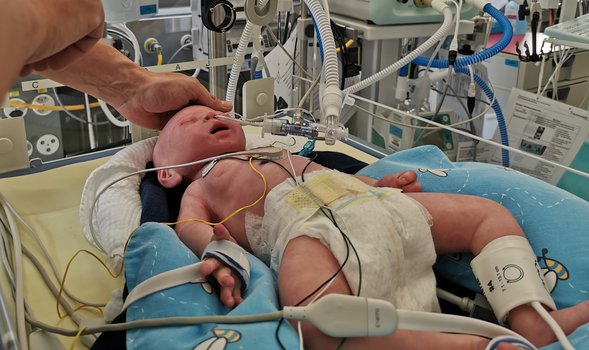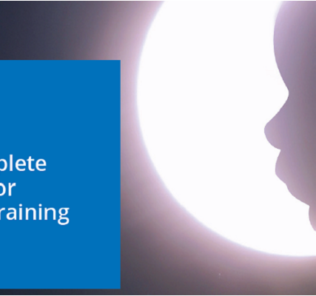Baby Lung Simulator LuSi Responds to Respiratory Therapy
For the training of NICU clinicians, LuSi is a baby simulator which responds to invasive and non-invasive respiratory therapy without need for operator input and thus creates a truly immersive simulation experience. Today Dr. Josef X. Brunner PhD, CEO at neosim AG shares about the new LuSi infant simulator, which was developed to train clinicians in the assessment of lung function and the application of respiratory therapy without risk to patients. Dr. Brunner shares:
The artfully hand-painted silicone body looks like a real patient and covers high-tech machinery: an artificial lung, computerized and loaded with sensors to simulate lung function of a premature baby. In contrast to existing simulators, LuSi reacts fully automatic to treatments like oxygen or other forms of respiratory support.
LuSi’s lungs fill and empty with actual air and oxygen enriched air, whatever the therapy chosen. Oxygen, volume and pressures inside the lungs are measured, the lungs can be made atelectatic or recruited, airways can be made to be open or obstructed and spontaneous breathing in many forms can be realised. The resulting alveolar ventilation is driving the physiological models built into LuSi which in turn determine blood gases and heart lung interaction. The result of these calculations are made visible to the learner through the built-in vital signs monitor — in real-time.
Sponsored Content:
The autonomous baby lung simulator LuSi can be treated with most respiratory support devices, including high-flow oxygen therapy, nasal CPAP or invasive ventilation. LuSi reacts autonomously to treatment without operator interaction. The dedicated vital signs monitor provides real-time curves and data, including pre-ductal and post-ductal pulse oximetry, respiratory impedance measurement with ECG, transcutaneous PCO2 and even end-tidal CO2 measurement. The monitor is configurable so that it can be set to look like most devices on the market.
No operator interaction is needed. Consequently, there is no need for an expert to tweak the vital signs because LuSi is autonomous and guaranties consistent outcomes. Therefore medical simulation training can be done by a single trainer.
LuSi enables new approaches to simulation based training since LuSi can be used even without trainer presence. Selecting a pathology is enough to create a case – and respiratory therapy can be applied as-if LuSi would be a real patient. LuSi will react autonomously in real-time and create vital signs which can be used to guide therapy by the learner until she/he accepts and declares successful treatment. Since pertinent data is stored, debriefing can be done any time after the simulation.
Healthcare simulation based training becomes affordable for even small neonatal intensive care units when you factor in the costs of near-misses or catastrophic system failure.
Sponsored Content:
LuSi is programmed with LuSiLIFE, a scenario building, PC based program. LuSiLIFE enables rapid execution of pre-assembled clinical simulation scenarios, loading of patient case libraries, on-the-fly changes if necessary, notes-taking to remember certain incidents for debriefing, and complete data recording for later analysis. Patient cases can readily be imported and exported for sharing with other LuSi users. All data is completely transparent in .json format.
Technically, the airway opening leads to a lung compartment with real physical properties such as compliance and resistance. The lung takes tidal volumes up to 35ml and pressures up to 50mbar. Integrated motors make the lungs fully recruited or collapsed, depending on the selected pathology. The lungs are driven by further motors for variable and programmable respiratory activity. Airflow resistance is adjustable. Integrated pressure, oxygen and volume sensors measure the administered level of therapy, the integrated microprocessor calculates real-time outcome parameters in real-time, including venous admixture, pre-ductal and arterial oxygenation.
The real-time data is transferred wirelessly to a monitor and is displayed as wave forms and trends, including ECG, SpO2 plethysmogram, capnogram, respiratory impedance curves and transcutaneous PCO2. Blood pressure, heart rate and temperature display add to a fully immersive simulation experience. Access to blood gas values and spirometric data allows to obtain lab data with timing determined by the trainer.
LuSi connects to any laptop via Bluetooth and can be used in the hospital setting or out-of-hospital in any training facility without further equipment, completely tetherless and wireless. The fully configurable vital signs monitor can be set to look like most devices on the market.
Last but not least, LuSi can be calibrated to account for sensor drift and component aging. Calibration is completely automatic and creates a pass/fail report for quality assurance record keeping.
LuSi is available in Europe and directly from the manufacturer. This policy ensures that the low price and high quality service are provided to the end-users, the trainers and learners in the NICU.
About neosim AG
neosim is a Swiss company founded by experts with strong background in lung physiology and mechanical ventilation of intensive care patients. The mission of neosim is to bring high-fidelity physiology and pathophysiology to the patient simulator community.
For training and education of clinicians, especially respiratory therapists and intensive care professionals, neosim simulators create realistic breathing in health and disease. In contrast to other simulators, neosim’s simulators can be treated with intensive care therapy methods and responds like a real human patient. The result manifests itself clinically and can be measured quantitatively with state-of-the-art monitoring in real-time. Head quarters are located in Chur, Switzerland.
Learn More About LuSi from neosim AG here!
Today’s article was guest authored by Dr. Josef X. Brunner PhD, CEO at neosim.
Have a story to share with the global healthcare simulation community? Submit your simulation news and resources here!
Sponsored Content:















